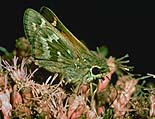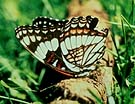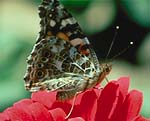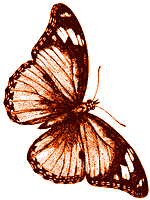Behaviors to Watch
Feeding
Most species of local northern butterflies use flower nectar as their primary food source (Table 3). This sugar-rich material is required for energy used in flight. Very long- lived tropical butterflies in Florida, of the family Heliconiidae, also feed on pollen.
Table 3. Some suggested nectar plants for adult butterflies.
Back to "Creating a Butterfly Garden"
- Shrubs
- Azalea, blueberries, butterfly bush, buttonbush, lilac, privets, and sumacs
- Cultivated Flowers: Annuals
- Coneflowers, flowering tobacco, impatiens, marigolds, phlox, sunflower, and verbena
- Cultivated Flowers: Perennials
- Asters, bee balm, butterfly weed, chrysanthemums, daisies, live forever, purple coneflower, sedum, and yarrow
- Wildflowers
- New England aster, bergamots or horsemints, black-eyed Susan, blazing stars, boneset, butterfly flower, coreopsis, ox-eye daisy, and purple agertum
Some weedy wildflowers are not appropriate for
formal garden settings, but could be used in a wild
patch: common milkweeds, dogbane, goldenrods,
ironweeds, Joe-Pye weed, nettles, and thistles
 Source: University of Minnesota
Source: University of Minnesota
James Ford Bell Museum of Natural History.
Used with permission.
Some butterflies, such as the Mourning Cloak (Nymphalidae: Nymphalis antiopa) and Hackberry (Apaturidae: Asterocampa celtis) feed on rotting fruit, sap that oozes from trees, and even dung.
The Leonard’s skipper (Hesperiidae: Hesperia leonardus) extends its proboscis into flowers to obtain nectar.
 |

Painted Lady butterflies (Nymphalidae: Vanessa cardui) prefer composit family flowers such as zinnia for feeding. |
Monarchs (Nymphalidae: Danaus plexippus) will stop to feed on nectar from plants such as this blazing star.
 |

Weidemeyer’s Admiral (Nymphalidae: Limenitis weidemeyerii) is one butterfly species that will feed on dung, in this instance coyote dung.
|
Basking
This Checkered skipper (Hesperiidae: Pyrgus communis) shows the most common basking position, with wings flat and facing the sun to maximize capture of the sun’s rays on its dark wing surfaces.
 |
Butterflies are cold-blooded creatures. They may need the sun to warm their wing muscles so they can fly. They fly best when air temperatures range from 75-90 degrees; so when it’s cooler, they bask, using the sun’s heat to warm their bodies. A large, flat rock in the butterfly garden provides a warm spot for basking when the temperatures are cool. When temperatures get too warm, butterflies seek shade.
The most common basking position is with the wings positioned flat, facing the sun. Butterflies that bask this way often have black bodies and dark colored areas on their wings. Most common among Satyrs (Satyridae) and Sulphurs (Pieridae) is lateral basking with wings folded and facing the sun. This is because the undersides of their wings are darker than the topsides, or the bases of the wings are darker than the edges. In a third type of basking, called reflectance, the wings are used to reflect the sunlight to the butterfly’s body rather than absorb it. Butterflies that use reflectance basking, such as whites, have lighter colored wing ends.
Puddling
Some butterflies drink fluid from the soil to obtain needed salts and nutrients (Nymphalidae: Limenitis arthemis).
 |
Butterflies congregate at the wet edge of mud puddles or wet sandy areas, where they imbibe fluids rich in salts and nutrients. Butterflies require these extra salts and other nutrients to mate successfully. Typically, more males than females puddle. Males pass the nutrients on with their sperm and these nutrients are used by the females for reproduction.
Nutrients gained from puddling also help in producing pheromone. This is the chemical sexual attractant released by males to attract females to mate.
Patrolling and Perching
For the purpose of mating, male butterflies search out female butterflies in two ways, by patrolling and perching. In patrolling, the male butterflies fly over areas where the female butterflies may be feeding or egg-laying. Butterflies do not, however, have sharp vision; so once a patrolling butterfly spots what he perceives to be a likely mate, he swoops down and examines it more closely. If it’s indeed a female of his species, he will begin the courting ritual.
With some butterflies, males perching on tall plants may
be on the lookout for mates (Nymphalidae: Vanessa cardui).
 |
Some butterflies that commonly use a patrolling strategy include the Monarch, Sulphurs and Whites. When butterflies fly upward next to one another, they are either males combating one another for territory, or males trying to convince females to mate with them.
Instead of patrolling, butterfly species such as the Mourning Cloak (Nymphalidae: Nymphalis antiopa), Black Swallowtail (Papilionidae: Papilio polyxenes) and Red Admiral (Nymphalidae: Vanessa atalanta) will perch on tall plants in areas along streams or ridges where the females are likely to occur. Once they spot something that might be a female, they will fly in to explore it closely. If they have found a female of the appropriate species, they will begin courtship. If the intruder turns out to be a male, the original male will give chase. Generally they will fly vertically for a few feet after which the original male returns to his perch.
Nymphalidae: Mimic
butterfly (male) |
 |
 |
Nymphalidae: Mimic
butterfly (female) |
Mating
Flight patterns used in courtship differ among the butterfly species. Typically, a male will fly above or behind the female, fluttering his wings a bit more than usual. He may release pheromones from his body or wings. If the female is interested, she’ll alight on plants or on the ground. Sometimes courtship continues with the male touching the female’s antennae or legs and with different wing movements. They copulate by joining the tips of their abdomens. Sometimes they even take flight during copulation while still joined.
The mated female may try to avoid the advances of other courting males. With many species, the female physically avoids contact either by positioning her abdomen tip or spreading her wings in a manner to make contact impossible, or by releasing antiaphrodisiacs. Still other species, such as Sulphurs, fly upward in a spiral until the male gives up the chase.
The Monarch (Nymphalidae: Danaus plexippus) female lays her eggs on milkweed, a larval host for the species.
 |
Egg-laying
If you notice a butterfly flying over plants, then touching down briefly, you are watching a female searching for egg-laying sites. Female butterflies recognize host plants through visual cues, such as leaf shape and color. Plant scent further identifies a potential host.
Female butterflies also often drum on the leaf surface with their feet. Drumming scratches the leaf surface, releasing chemicals enabling the butterfly to identify the correct plant on which to lay her eggs. Table 2 is a list of host plants for common butterflies.









